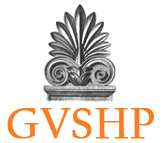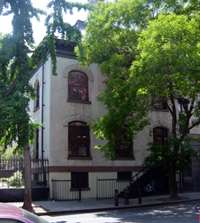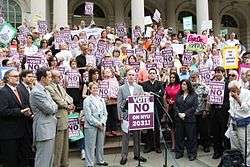Greenwich Village Society for Historic Preservation
 | |
| Formation | 1980 |
|---|---|
| Headquarters | New York, NY |
| Website | |
The Greenwich Village Society for Historic Preservation (GVSHP) is a non-profit membership organization that seeks to document, honor and preserve the architectural heritage and cultural history of several downtown New York City neighborhoods: Greenwich Village, the Far West Village, the Meatpacking District, the South Village, NoHo, and the East Village.
In these historic neighborhoods, GVSHP seeks both to protect historic resources and to monitor new development via an array of advocacy and outreach efforts, involvement in governmental process and public discourse, and educational programs for adults and children. Its work toward securing historic district and landmarks protections, saving significant buildings from demolition, securing contextual zoning for sections of neighborhoods, and right-sizing plans for new construction has earned wide praise from preservation leaders.[1] GVSHP has helped secure designation of ten new historic districts or district extensions, landmark status for dozens of buildings, and four contextual rezonings.[2]
GVSHP has received numerous distinctions in preservation and real estate circles,[3] such as the Preservation League of New York State's "Excellence in Historic Preservation Award" for organizational excellence,[4] and Executive Director Andrew Berman's inclusion in the The New York Observer's "The 100 Most Powerful People in New York Real Estate." [5]
History


GVSHP was founded in 1980 as the Greenwich Village Trust for Historic Preservation (GVT). In 1982, Regina Kellerman, a prominent architectural historian and co-founder of GVT, was named as its first executive director, and GVT moved its operations to the Salmagundi Club at 47 Fifth Avenue. In 1984, GVT changed its name to the current one, Greenwich Village Society for Historic Preservation.
Throughout the 1980s, GVSHP initiated research on the history and architecture of Greenwich Village, including subjects like the Gansevoort Meat Market (a joint study with Columbia University), Bleecker Street, Broadway, and maritime history of the Greenwich Village waterfront.
In 1991, GVSHP launched its first educational program, “Greenwich Village: History and Historic Preservation,” as a joint effort with the Merchant's House Museum, and, in 1995, designed and published a 12-page children’s workbook, “Discovering Greenwich Village,” for distribution to children in the school program.[6] The education program has since been expanded to include field-trip style walking tours of Greenwich Village, encouraging students to examine the architectural form of Greenwich Village as a manifestation of its social history and context.[7]
In the mid-1990s, GVSHP initiated an oral history project to document the experiences of Village preservationists of the twentieth century, many of whom were involved in defeating Robert Moses's Lower Manhattan Expressway. The participants in the oral history project include famous Village residents such as Jane Jacobs, Edwin Fancher, and Doris Diether.[8]
Since 1999, GVSHP has operated from the Neighborhood Preservation Center, the former rectory of St. Mark's Church in-the-Bowery, on East 11th Street, and increased its focus on the East Village since moving its office to that neighborhood.
Major ongoing efforts include advocacy around the proposed transfer of development rights in Greenwich Village along the Hudson River Park;[9] supporting local independent businesses; and opposing NYU’s expansion plans, as by being a co-plaintiff in a lawsuit to overturn approvals granted for “NYU 2031.”[10] The group consistently testifies before the New York City Landmarks Preservation Commission, and monitors applications for alterations to protected buildings.[11]
Work
GVSHP has taken the lead in advocating for designation of the South Village as a historic district. The first section of this historic district was designated in 2010, and a second in 2013, but the group continues to press for a third section to be landmarked.[12] In the West Village, the group celebrates the singular role the area has played in the LGBT civil rights movement, and has advocated for several official recognitions of this history.[13] As the Real Estate Board of New York (REBNY) has increasingly faulted preservation protections for New York City’s housing affordability crisis, GVSHP has consistently rebutted those claims.[14]
GVSHP responds to development and preservation issues as they arise, but also hosts a full yearly calendar of community, educational and commemorative programs. Each month, the group offers several free programs, including lectures, walking tours, panel discussions, house tours, and more. The organization's primary annual fundraiser is the Village House Tour, held on the first Sunday each May. Its major members’ event is the Village Awards and Annual Meeting in June, at which important local citizens, businesses, and civic groups are recognized for their work benefiting the community.[15]
In 2014, the organization produced a book of stories and artworks entitled “Greenwich Village Stories,” published by Rizzoli. This collection of art and text by contributors including Nat Hentoff, Lou Reed, Hettie Jones, Saul Leiter and Jane Freilicher is sold through mainstream booksellers as a partial fundraiser for GVSHP.[16] In partnership with a local business, the group places two historic plaques per year on sites of cultural or historic importance, such as the former location of the San Remo Café in July 2013 and the former home of poet Frank O’Hara in June 2014.[17]
GVSHP also runs a children’s program through local schools, employing trained educators to teach students how history can be understood through the built environment, using Greenwich Village as a living museum.[18] A continuing education program for real estate professionals includes lectures, slide shows and walking tours on aspects of architecture, zoning, and planning history.[19] Another ongoing project that promotes an understanding of the Village’s historic importance is the Greenwich Village Preservation Archive and Oral History Project,[20] which collects the reflections of preservation pioneers and Westbeth leaders, as well as residents of the South and East Village. The organization also publishes a daily blog of local and historical interest called “Off the Grid,” as well as "The Anthemion," a semiannual newsletter detailing the status of its advocacy and other projects.
Landmarks designation efforts

Although a large portion of the Village was designated in 1969 as part of the Greenwich Village Historic District, many buildings outside the district’s boundaries are unprotected. During the decade between 2003 and 2013, GVSHP helped secure landmark designation of over 1,100 buildings, as well as community-scaled "contextual rezonings" of nearly 100 blocks.[2]
Some of its more notable efforts include:
- 2012 – East Village/Lower East Side and East 10th Street Historic District designated the first new historic districts in the East Village since 1969.
- 2011 – Westbeth Building declared an official City landmark (added to State & National Register of Historic Places since 2009)
- 2009 – East Village rezoning passed by NYC Council
- 2009 – Silver Towers designated as an individual landmark by the NYC Landmarks Preservation Commission
- 2009 – Webster Hall designated as an individual landmark by the NYC Landmarks Preservation Commission
- 1999, 2002, 2009 – NoHo Historic District (Main, East, and Extension, respecticely) designated by the NYC Landmarks Preservation Commission
- 2006 – Weehawken Street Historic District designated by NYC Landmarks Preservation Commission
- 2004 – Hamilton-Holly House at 4 St. Marks Place and 127-131 MacDougal Street designated as individual landmarks by the NYC Landmarks Preservation Commission
- 2003 – Gansevoort Market Historic District designated by NYC Landmarks Preservation Commission
- 2002 – Gansevoort Market named one of Seven to Save by Preservation League of New York State
- 1999 – Stonewall Inn added to National Register of Historic Places (joint effort with Organization of Lesbian and Gay Architects and Designers)
Selected honors and awards
- 2013 – Vanity Fair's “Hall of Fame”: GVSHP’s Executive Director Andrew Berman was named to the magazine’s “Hall of Fame” for being “the pesky David to the Goliath developers who have come to define post-millennial Manhattan … savvy and pugnacious enough to recognize that there is no respite for the preservationist, ever, from those who would make the Village ‘bigger, glassier, newer.’”
- 2008 – The New York Observer's “100 Most Powerful People in New York Real Estate”: GVSHP’s Executive Director Andrew Berman was recognized by the Observer in 2008 for work in standing up to overdevelopment within Greenwich Village and its environs. Among the list of real estate developers, financiers, brokers, and government officials, Berman was the only neighborhood preservation advocate chosen to make the list of the “100 Most Powerful People in Real Estate.”
- 2007 – The Preservation League of New York State's Excellence in Historic Preservation Award: Of GVSHP, PLNYS said, “The Greenwich Village Society for Historic Preservation’s efforts to build grassroots support, and to monitor and inform the decisions of New York City agencies should serve as an inspiration to other preservation organizations. GVSHP recently achieved a number of preservation goals that for decades had proved elusive. From the implementation of measures to protect the historic buildings and character of the Far West Village and Greenwich Village waterfront, to the designation of the Gansevoort Market Historic District, once-endangered buildings are now protected.”
- 2006 – The Village Voice's “Best Greenwich Village Defender” in “Best of NYC 2006": The Village Voice writes that “It’s been a big year in the push to preserve the Village, thanks largely to the Greenwich Village Society for Historic Preservation. The group’s vigilant director, Andrew Berman, has exhibited a knack for stopping 'out of context' buildings from sprouting up on quaint, historic streets, despite the red-hot development pressures."
- 2006 – New York Magazine’s “Influentials 2006”: New York Magazine says of Berman, "He persuaded the City Council to stop a spate of 'out of context' buildings in their tracks. Now he’s taking on NYU, determined not to let the university take over the neighborhood in its expansion.”
- 2006 – New York Landmarks Conservancy's Lucy G. Moses Organizational Excellence Award: The NYLC established the Lucy G. Moses award to "recognize the property owners, builders, artisans, and designers who renew the beauty and utility of New York City’s distinctive architecture."
Historic districts
The following designated historic districts fall within GVSHP's purview, followed by the year in which they were designated in parentheses:
- Charlton-King-Vandam Historic District (1966)
- MacDougal-Sullivan Gardens Historic District (1967)
- Greenwich Village Historic District (1969) and Extension I (2006) (includes Stonewall National Register District) and Extension II (2010)
- St. Mark's Historic District (1969) and extension (1984)
- NoHo Historic District (1999) and extension (2008)
- NoHo East Historic District (2003)
- Gansevoort Market Historic District (2003)
- Weehawken Street Historic District (2006)
- Noho Historic District Extension I (2008)
- East 10th Street Historic District (2010)
- East Village/Lower East Side Historic District (2012)
- South Village Historic District (2013)
See also
- New York City Landmarks Preservation Commission
- List of New York City Designated Landmarks in Manhattan below 14th Street
- National Register of Historic Places listings in Manhattan below 14th Street
References
- ↑ The Greenwich Village Society for Historic Preservation. "What they're saying about GVSHP". Retrieved 2014-07-09.
- 1 2 The Greenwich Village Society for Historic Preservation. "Ten Years: A Thousand Buildings: One Hundred Blocks" (PDF). Retrieved 2014-07-09.
- ↑ The Greenwich Village Society for Historic Preservation. "Honors for GVSHP". Retrieved 2009-04-22.
- ↑ Preservation League of New York State. "PLNYS Award Recipients 2007". Retrieved 2009-04-22.
- ↑ The New York Observer. "The 100 Most Powerful People in New York Real Estate". Retrieved 2009-04-22.
- ↑ The Greenwich Village Society for Historic Preservation. "GVSHP Milestones and Victories". Retrieved 2009-04-17.
- ↑ The Greenwich Village Society for Historic Preservation. "Kid's Ed". Retrieved 2009-04-29.
- ↑ The Greenwich Village Society for Historic Preservation. "Oral History Collection". Retrieved 2009-04-29.
- ↑ Spokony, Sam. "Community confronts park air rights issue as Cuomo O.K.'s bill". The Villager. Retrieved 26 June 2015.
- ↑ The Greenwich Village Society for Historic Preservation. "New York University". Retrieved 2014-07-09.
- ↑ The Greenwich Village Society for Historic Preservation. "Landmarks Application Webpage". Retrieved 2014-07-09.
- ↑ The Greenwich Village Society for Historic Preservation. "Protecting the South Village". Retrieved 2014-07-09.
- ↑ The Greenwich Village Society for Historic Preservation. "LPC Celebrates Gay Pride, Doesn't Designate Gay Landmarks". Retrieved 2014-07-09.
- ↑ The Greenwich Village Society for Historic Preservation. "Preservation Can Help Affordability". Retrieved 2014-07-09.
- ↑ Amateau, Albert. "Society honors butcher, boats, bookstore, B.B.C., burial ground". The Villager. Retrieved 26 June 2015.
- ↑ The Greenwich Village Society for Historic Preservation. "Greenwich Village Stories". Retrieved 2014-07-09.
- ↑ Epstein, Andrew. "New Frank O'Hara Plaque Unveiled in New York". Locus Solus: The New York School of Poets. Retrieved 26 June 2015.
- ↑ The Greenwich Village Society for Historic Preservation. "Kid's Ed". Retrieved 2014-07-09.
- ↑ The Greenwich Village Society for Historic Preservation. "Continuing Education". Retrieved 2014-07-09.
- ↑ The Greenwich Village Society for Historic Preservation. "Oral History Collection". Retrieved 2014-07-09.